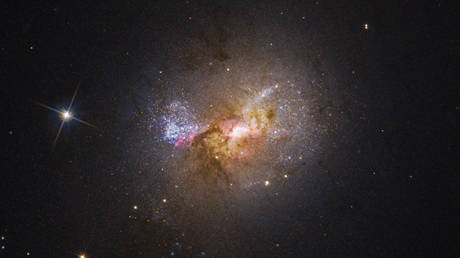
NASA’s Hubble telescope captures ‘nursery’ of newborn stars connected by an ‘umbilical cord’ to a black hole in a nearby galaxy
A black hole has been observed “triggering the birth” of new stars in a nearby dwarf galaxy, suggesting that the mysterious cosmic phenomena are more than just “villainous” destructive objects that violently consume everything around them.
Using NASA’s Hubble Space Telescope, researchers spotted the black hole at the heart of a galaxy known as Henize 2-10, located some 30 million light years away in the Pyxis constellation. The black hole is apparently adding to the “firestorm of new star formation” in Henize 2-10, according to findings published on Wednesday in the Nature journal.
Given the smaller size of Henize 2-10 – which contains only a tenth of the number of stars in the Milky Way, the black hole is not as massive as those found in larger galaxies. Its mass has been estimated to be around one million times that of the Sun.
This has meant that the “outflow” of plasma (ionized gas) from the black hole is comparatively gentler, allowing gas clouds to compress in a way that is conducive to creating new stars.
In larger galaxies, any material that falls towards the black hole is quickly destroyed by the powerful magnetic fields that surround it. This process creates jets of plasma that travel at almost the speed of light. Gas clouds caught in the blasts become too hot to cool down and form stars.
In contrast, Hubble spectroscopy showed the researchers that the outflow in the Henize 2-10 black hole was only moving at about one million miles per hour. This “low-velocity outflow” arrived at a region with a “dense cocoon” of gas, slamming into it like a “garden hose hitting a pile of dirt” before spreading out and creating newborn star clusters.
READ MORE: ‘Monster’ black hole found in dwarf galaxy
The event was likened by NASA to an “umbilical cord” attached to a “bright stellar nursery.” It was captured by Hubble as a “corkscrew-like pattern in the velocities of the gas,” which researcher Amy Reines said was “smoking-gun proof” that the activity was related to a black hole – and not the remains of a supernova explosion at the end of a massive star’s life.
Besides hinting at a larger role played by black holes, the new study might also add to existing knowledge about how they are formed and develop as they grow older. This is information that has “otherwise been lost to time and space,” Reines said.




